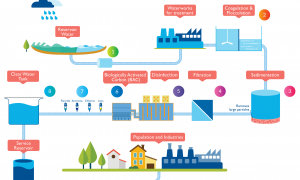🕑 Reading time: 1 minute
A cistern is an element of canal fall and it is provided on the downstream portion to dissipate the surplus energy of water leaving the crest. The purpose of a
Contents:
Purpose of Cistern
The main purposes of a cistern are as follows :
- To protect the downstream floor from the impact created by water jet/fall.
- To dissipate the energy of the waterfall by providing a water cushion.
- To generate
back flow of water by installing end-wall to ensure an impact in the cistern.
Types of Cisterns
Cisterns are classified into four types based on the type of impact :
- Vertical Impact Cistern
- Horizontal Impact Cistern
- Inclined Impact Cistern
- Cistern without impact
1. Vertical Impact Cistern
In case of vertical impact cistern, the flow from upstream fall freely under gravity after passing the crest and meet the cistern provided on the downstream bed. If there is no cistern on the downstream side, the downstream floor may be damaged by the impact created by the vertically falling water stream.

To provide cistern, some part of the downstream bed up to a certain length is depressed into the ground and this depressed portion is filled with water to create water cushion. Hence, when the flow falls from the crest, it meets the water cushion first and energy gets dissipated by means of impact and also the direction flow changes from vertical to the horizontal direction. Vertical impact cistern is the most effective cistern among other types.

2. Horizontal Impact Cistern
Horizontal impact cistern contains sloping glacis of reverse curvature at its bottom. When the water stream is passed over the crest, it flows to the downstream through sloping glacis provided. Here the flow is in inclined supercritical condition. When the flow reaches the bottom of the

At the bottom of the sloping glacis, the supercritical flow strikes the subcritical flow of the downstream water stream and hence horizontal impact will be created thus hydraulic jump will be formed. Due to the formation of a

3. Inclined Impact Cistern
In case of inclined impact cistern, sloping glacis is provided to carry the flow to the downstream but here reverse curvature at the bottom of glacis is eliminated. Hence, the formation of hydraulic jump occurs on the glacis itself and the energy gets dissipated.
But it is not possible to dissipate the complete energy of water stream since the stream has a vertical component of a
4. Cistern without impact
Cistern without impact or no impact cistern will not have any hydraulic impact. This case can be seen in low height canal falls or canal falls with large submergence where it is not possible to develop hydraulic jump. In such cases, roughening devices are installed on the cistern to dissipate the energy of water flow.



